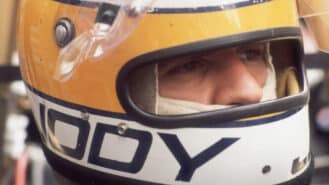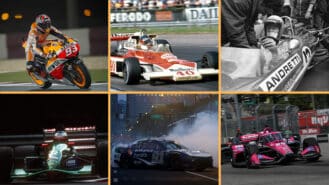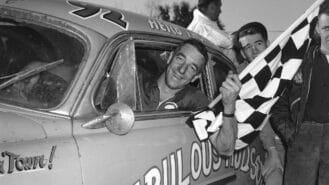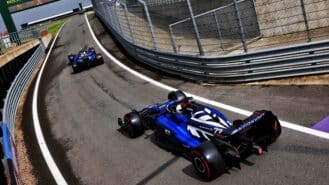The Nissan GT-R LM NISMO is a FWD/AWD LMP1-H racer that meets FIA WEC and ACO criteria and features a 3-litre TTV6 IC engine with DI, in conjunction with an 8MJ by-flywheel mechanical KERS system.

This hi-tech hybrid’s influences include AAR’s banned BLAT (Boundary Layer Adhesion Theory) Eagle Indycar of the early 1980s and its Toyota turbo-engined MkIII IMSA GTP dominator of the early 1990s.
And it’s got – now, these are numbers and letters guaranteed to make you sit up – 1250bhp.
Minimum.

British designer Ben Bowlby has again turned the sport on its head. This time he’s placed a 500bhp engine in front of the driver, its transmission ahead of the engine and radiators ahead of the transmission.
The 750bhp KERS unit is tucked beneath the driver’s legs.
Thinking outside the box, or off his box?
Bowlby’s needle-nosed, Siamese-wheeled DeltaWing of 2012 didn’t topple over at the first corner, so clearly he’s neither totally mad nor completely clueless.
God bless him, I say. Uniformity is strangling our sport and left us gasping for hippy-dippy-esque free spirits and free thinking.
That’s not to say Bowlby isn’t in thrall or ultimately constrained by modern motor sport’s fundamental parameter: aerodynamics.
By careful packaging for’ard, he has created a ‘catamaran’ underbody with wide, 15ft-long tunnels that run from splitter to diffuser and swage around a central V-hull-shaped cockpit. In this way he plans to provide downforce while reducing drag and increasing mph and mpg.
It’s a singular design with a singular aim: Le Mans.

Bowlby’s DeltaWing design is still racing in the USC
According to driver George Follmer, the 1970 Can-Am Shadow AVS MkI – the ‘Godzilla’s go-kart’ creation of Trevor Harris, whose fertile mind was also applied to the BLAT Eagle – “went down the straights like a raped ape.”
Well, Bowlby has attached electrodes to said primate’s privates to create a Nissan for the Mulsanne.
When talk is steered to torque steer, as inevitably it will, he will point out that all electrical current – the berries and full beans – will be stored until everything is pointed in the right direction and pulling about 70mph.
Plus, he’s put the fat (14in) tyres at the front and skinny (9in) ones at the back – as well as catered for balancing rearward KERS grunt.
Will it work?
Indeed, will it ultimately have or need 8 megajoules bearing in mind that last year Porsche and Toyota had to lower their sights to 6MJ and Audi won sports car racing’s biggest prize using only 2MJ?
Only time will tell.

What is already beyond question is that it’s won the PR war and, given that the WEC is once again attracting major manufacturers because of its more ‘obvious’ road-car link and lineage, that’s not unimportant.
Though not as important as winning, of course.
Bowlby has taken a (computer-) calculated risk with this futuristic machine, as history shows.
American John Walter Christie, a maker of gun turrets, was a patented pioneer of front-wheel drive. The idiot avantof the 1900s.
His entry for the 1907 French Grand Prix at Dieppe featured a 19.6-litre inclined V4 mounted across its nose and connected directly to independently suspended wheels via cone clutches that provided diff slippage.
Despite it having the largest engine capacity, the car was also the race’s lightest (810kg). As a consequence, it honked – bucked and weaved – down the many long straights of the 48-mile Circuit de la Seine-Inférieure.
And sucked and blew at its many corners.

Image: Vanderbilt Cup Races
Christie retired because of valve and clutch troubles after four-and-a-bit understeering, underwhelming laps – and turned his attention thereafter to taxis and suspension for tanks.
The American government snubbed him and he died virtually penniless before the fame and money due him – British and Russian tanks of WWII featured his ideas and innovations – arrived.
The packaging and traction benefits of front-wheel drive were revisited by motor sport during the mid-1920s – with mixed results.
The 1926-27 1.5-litre GP Alvis never raced in a GP and the concurrent V12 1100cc Itala voiturette never raced.
Both were designed by minds ultimately corrupted by innovation overload.
Artful genius Harry Arminius Miller and his chief draughtsman and shop foreman, Leo Goossen and Fred Offenhauser, took a more logical approach: design, build, develop and prove a winning drivetrain – and only then turn it on its ear, stand it on its nose, whatever.

Harry Miller at centre. Photo: IMS
Apparently at the bequest of ace driver Jimmy Murphy, who felt sure that the layout would provide more stable cornering and better traction at Indianapolis – particularly when its bricks were slick late in a 500 – Miller created a sensational low-line ‘puller’ powered by his superb 2-litre supercharged straight-eight.
Two were built at huge cost – they were 50 per cent more expensive than their rear-drive cousins – and entered at Indy in 1925 for Dave Lewis and Bennett Hill: Murphy, sadly, had been killed the year before.
That this was new territory was indicated by the drivers’ responses: Hill hated his car and it was withdrawn; Lewis, Miller’s brother-in-law, qualified his fifth and finished second.
That Miller, too, had much to learn was illustrated by the fact that Hill was happy to relief-drive the latter car – Lewis exhausted by its heavy steering – and charge in the later stages, unlapping himself and closing to within 54sec of the victorious Duesenberg of Pete de Paolo (and relief driver Norm Batten).
Earl Cooper and ‘Leon Duray’, real name George Stewart, put 1.5-litre versions on pole in 1926 and 1928 – the latter setting a qualifying record running on methanol that would last until 1937.
But it was not until the advent of the ‘Junk Formula’ in 1930 – a failed bid to encourage manufacturers back to Indy in place of thoroughbred specialists – that Miller’s back-to-front drivetrain took overall honours: winner Billy Arnold – a facial dead ringer for actor Tim Robbins – starting from pole and leading a record 198 laps.
Fred Frame (1932) and ‘Wild Bill’ Cummings (1934) added to its tally.
But Miller had hit the skids by then.
Declared bankrupt in 1933, he sold up to the canny Offenhauser and aligned with silver-tongued automotive golden boy Preston Tucker, the blueprint for John Zachary DeLorean and a future creator of… gun turrets.
Miller and Tucker, via Henry Ford’s eager-to-please and ambitious son Edsel, persuaded Ford Motor Company to tackle Indy in 1935.
It was a total bust.
Miller’s Ford V8-powered front-wheel-drive machines looked superb but were fundamentally flawed. Nine of the proposed 10 were built and only four qualified. And they all retired for the same reason: seized steering caused by overheating due to its proximity to a cylinder block.

Photo: IMS
Henry Ford was not amused and FoMoCo would not return until 1963 (as an engine supplier to Team Lotus).
Miller, an inveterate innovator to the bitter end – his final Indy challenger was an ill-fated, rear-engined, 4WD box of tricks – died a broken man in 1943.
Thus he missed FWD’s post-war Indy renaissance, when sonorous, Frank Kurtis-designed, supercharged Novi V8s captured speed records and the fans’ hearts, and stealthier, Goossen-designed, Offy-powered Blue Crown Spark Plug Specials, built by Emil Deidt, went on a three-year winning streak from 1947-49.
Veteran Chet Miller’s 1953 death – in a practice accident spookily similar to that which took the life of fellow Novi star Ralph Hepburn in 1948 – marked front-wheel drive’s Indy demise.
Until drag king Marion Lee ‘Mickey’ Thompson, another smooth operator running on a heady mix of creative juices and snake oil, decided that he knew better.
His 1965 front-engined, front-wheel-drive ‘dragster’ featured a titanium-tube backbone chassis, from which was cantilevered a Chevy V8. It was not without merit and driver Bob Mathouser did his utmost, but it failed to qualify after the best of its engines let go at a crucial juncture.

Thompson, another irresistible innovator – his final Indy Challenger (sic) was an ill-starred, front-engined, four-wheel-steer box of tricks – met a grisly end in 1988 when he and his wife were shot at their California home by unidentified gunmen.
Eee, eck!
Sorry, Ben, I didn’t plan for the article to end this way.
Please ignore most of the above and accept my best wishes for the most exciting, fascinating and intriguing motor sport project of the 21st century to date.
Avanti!












